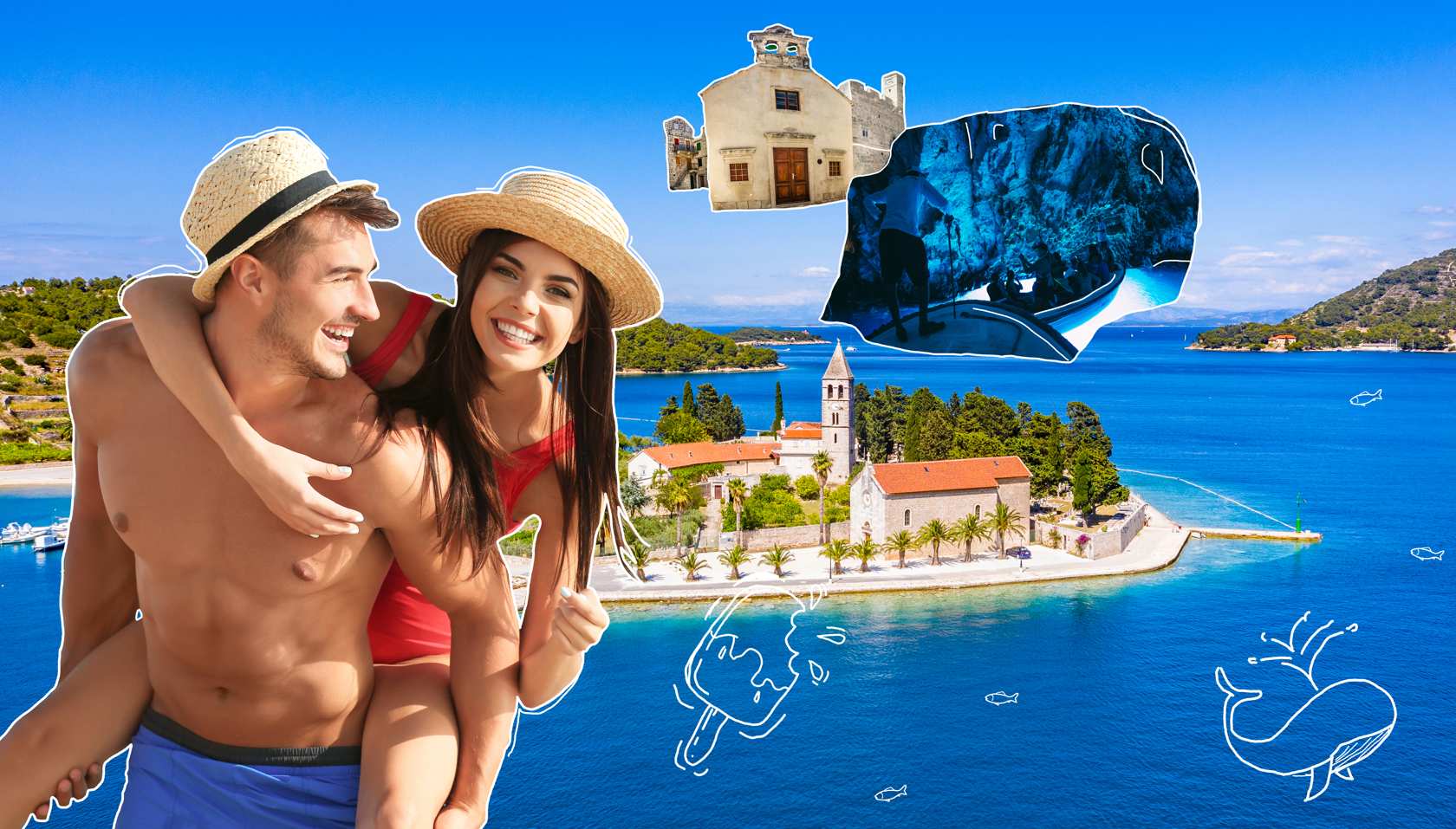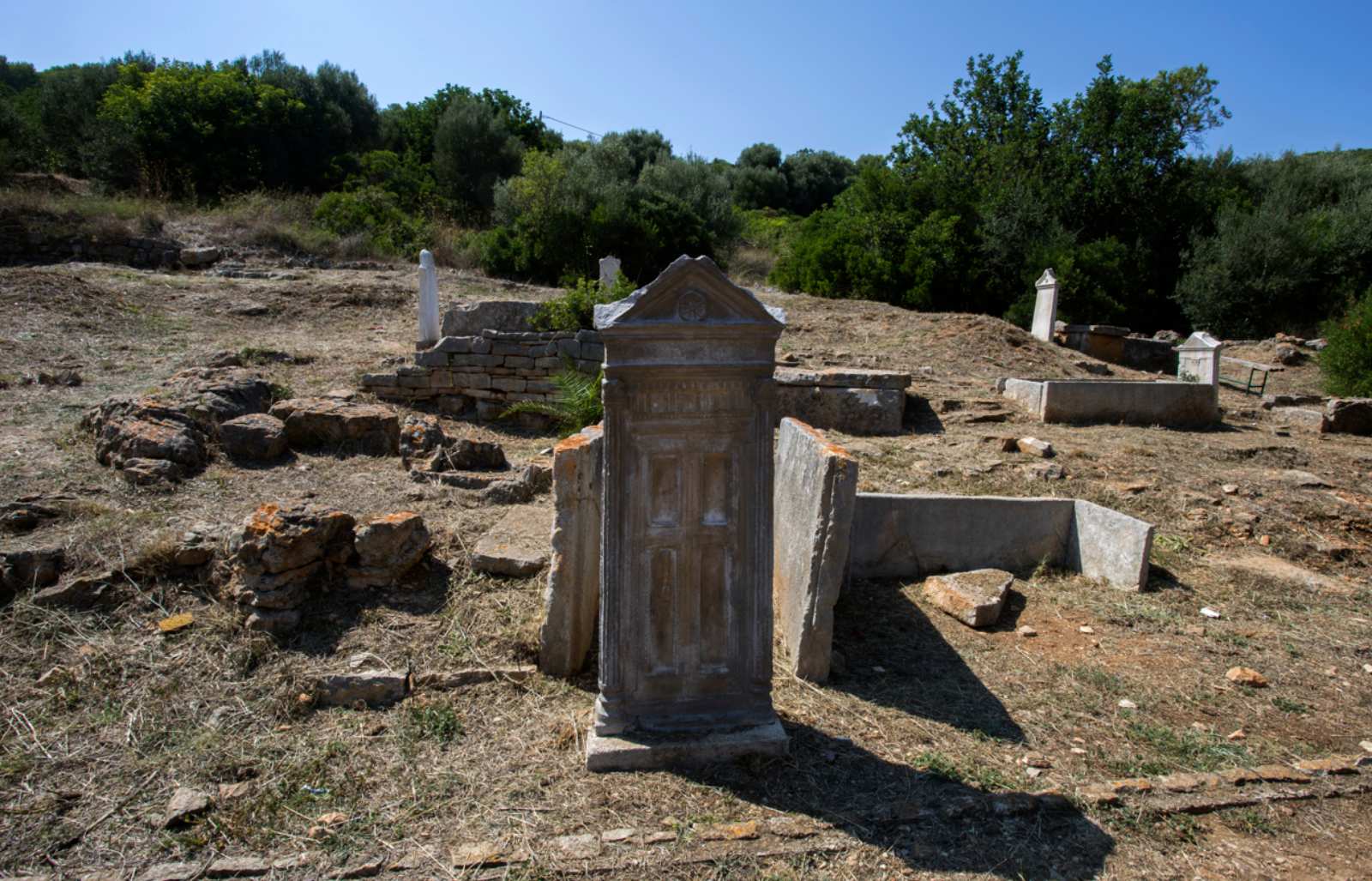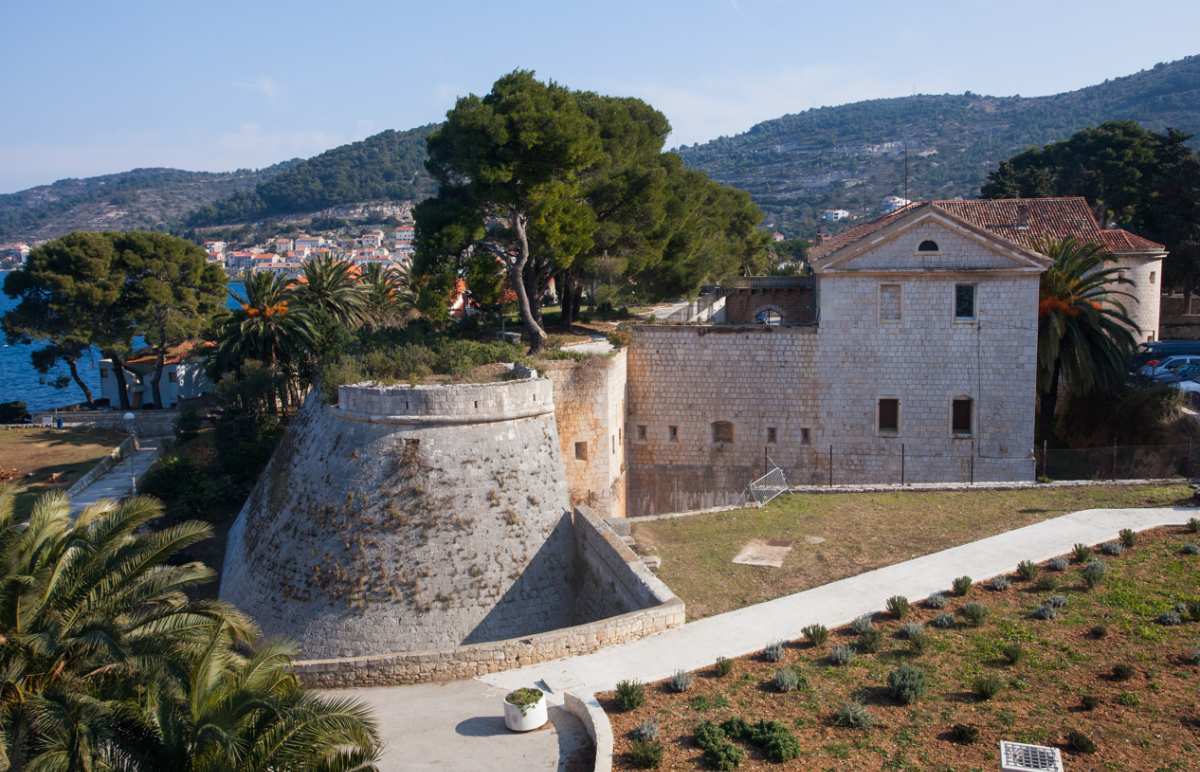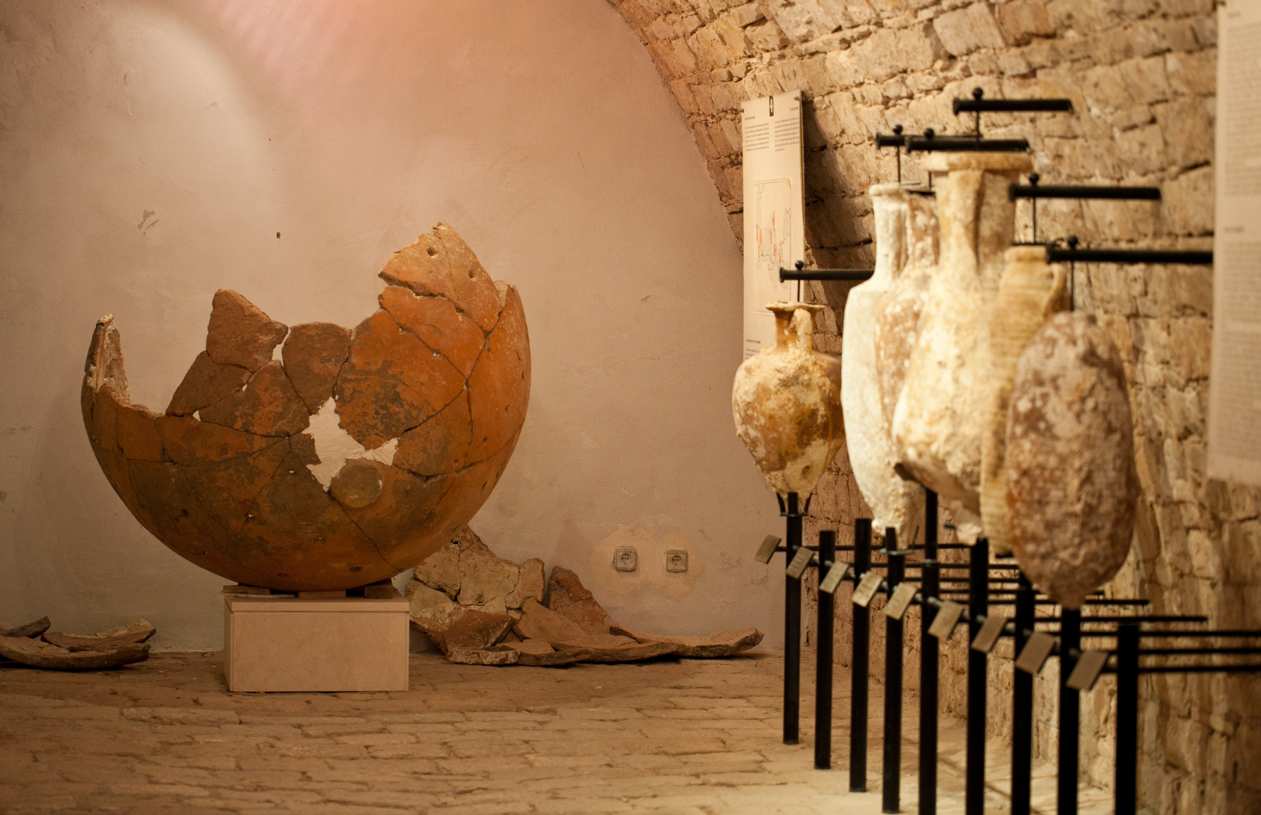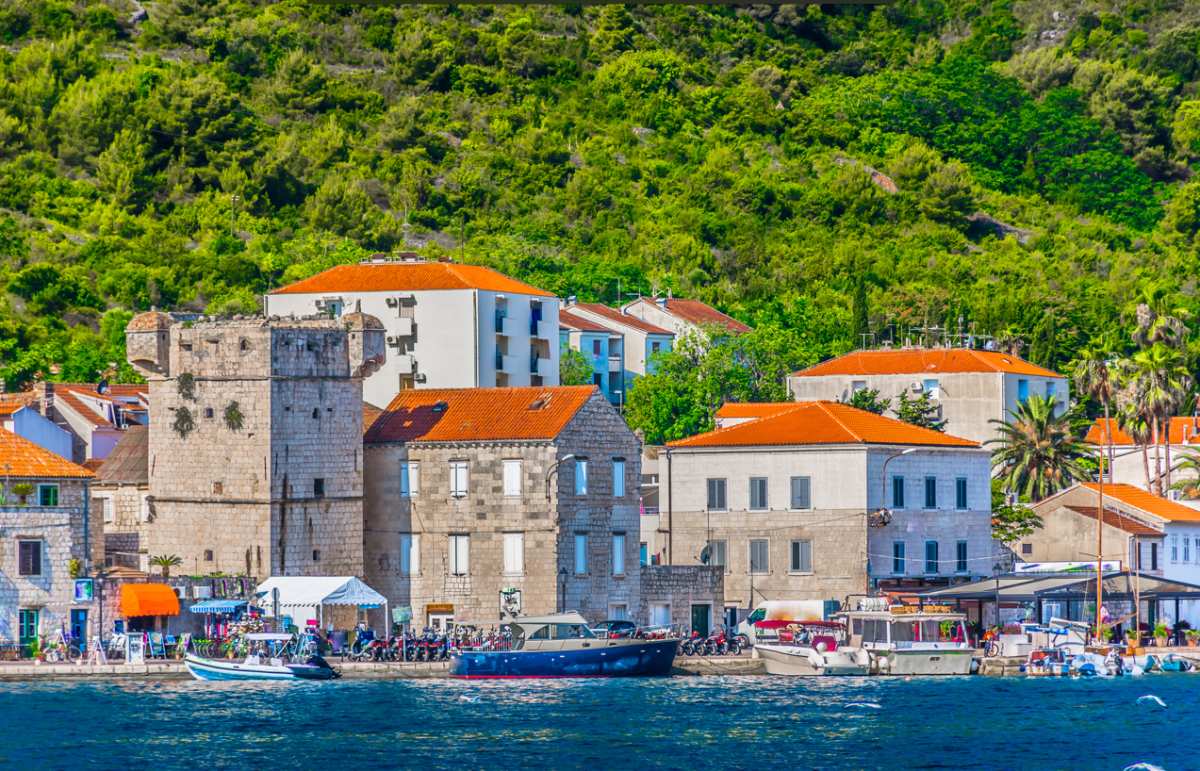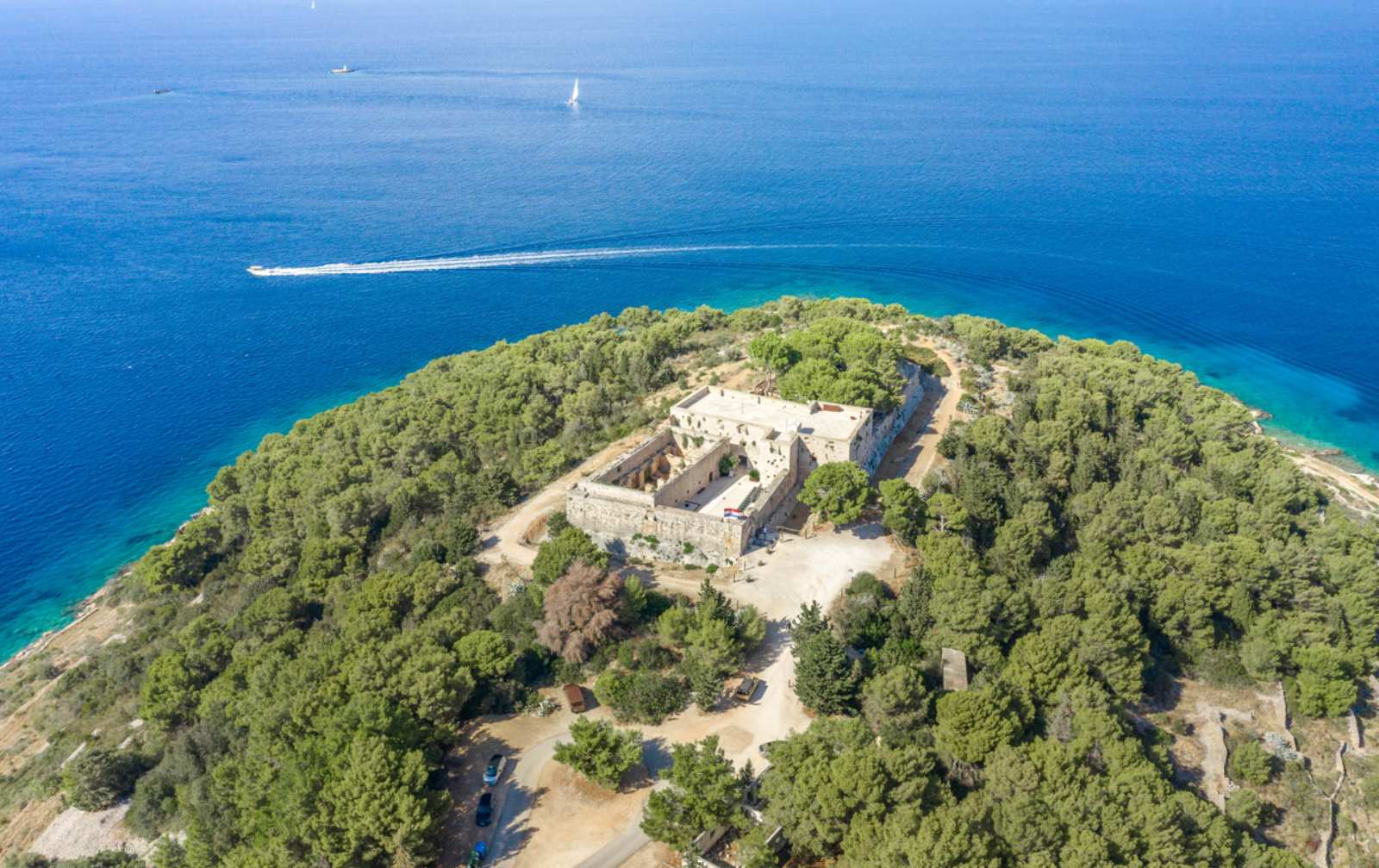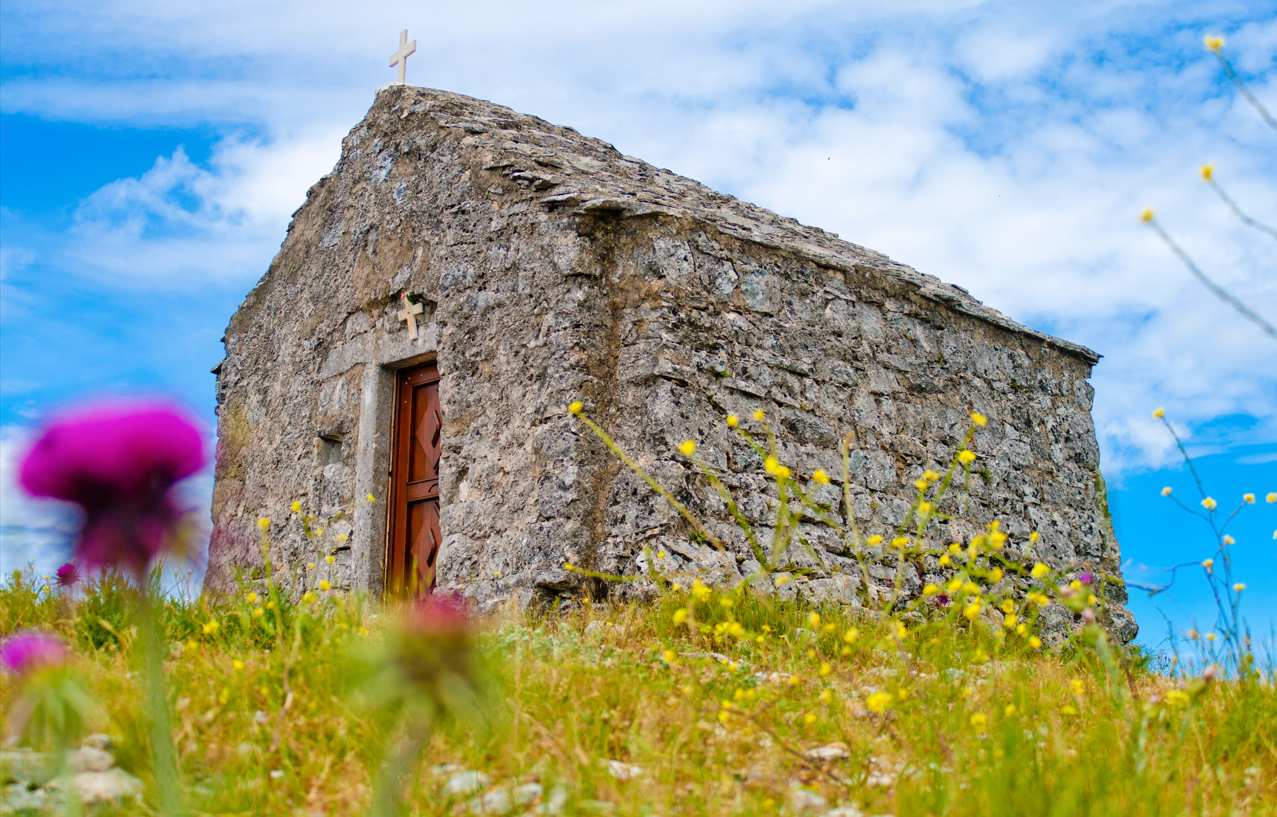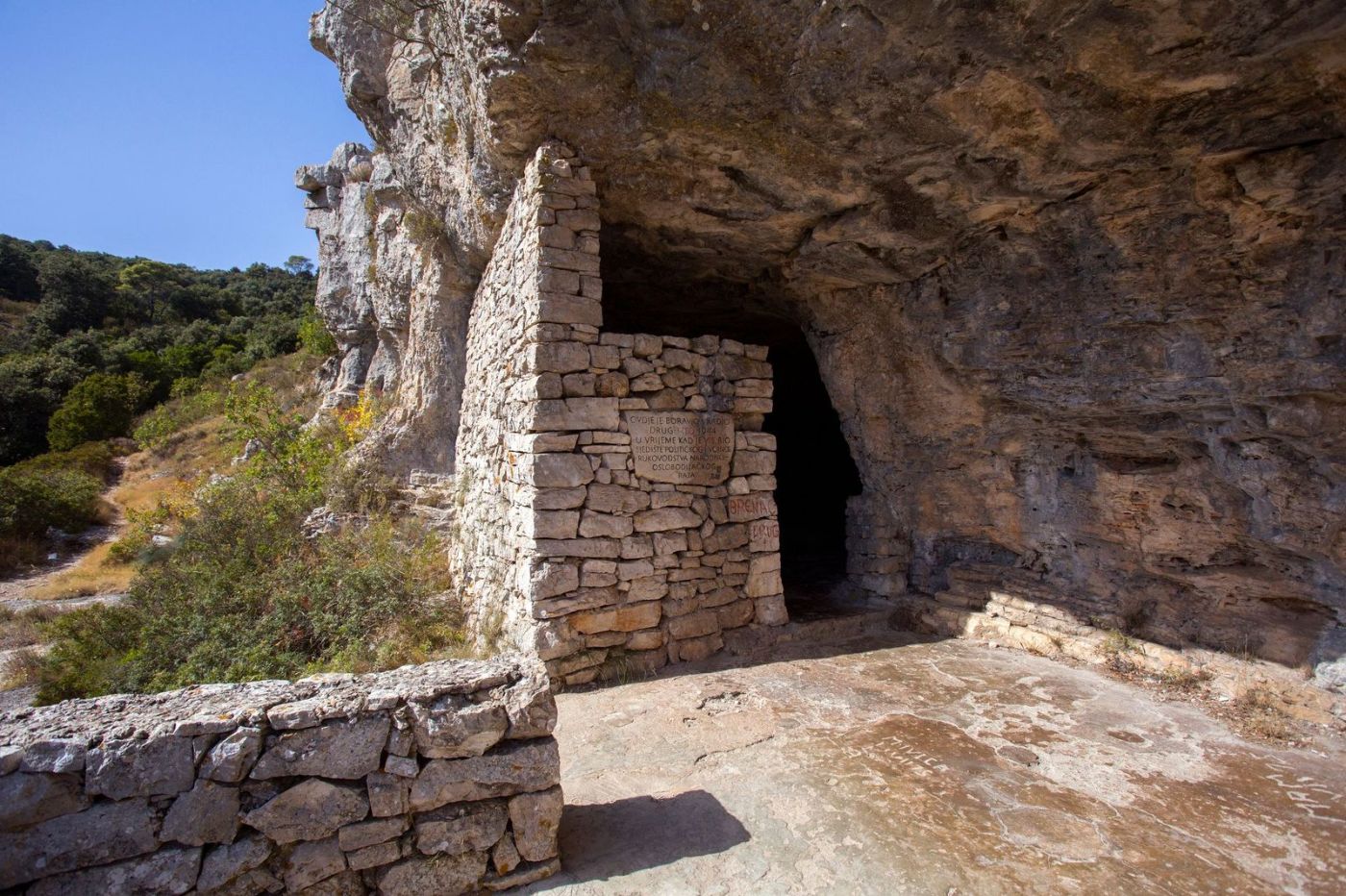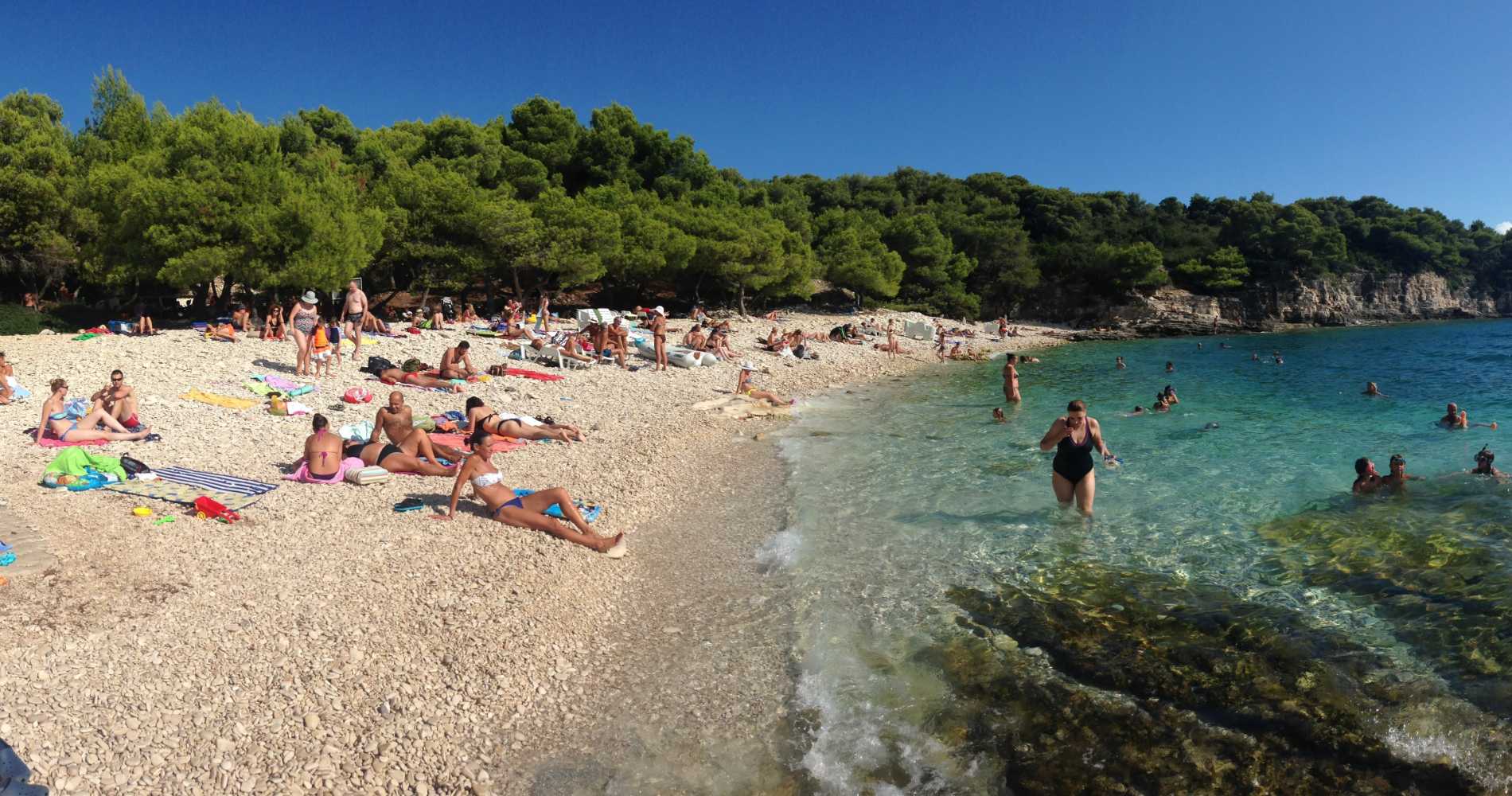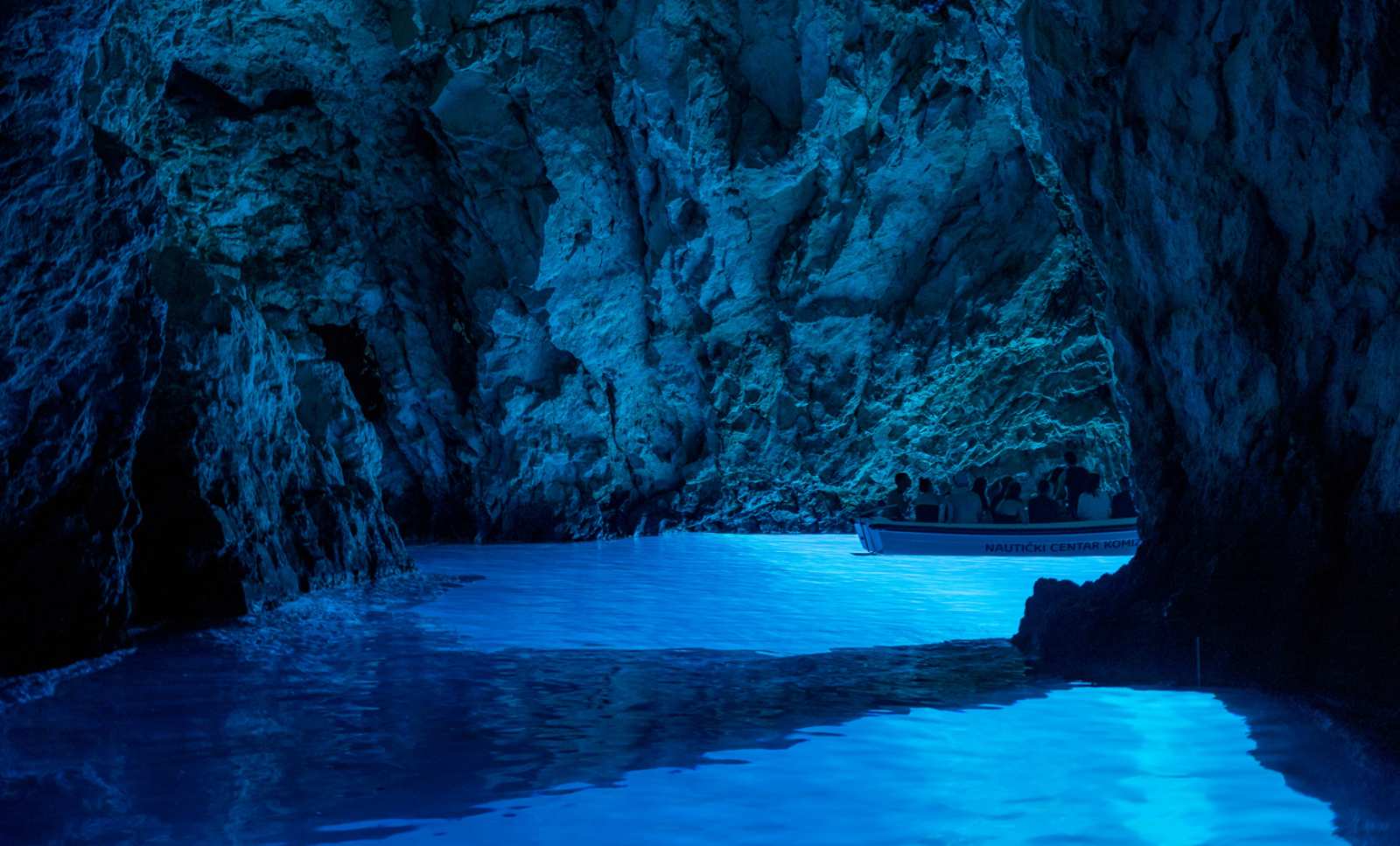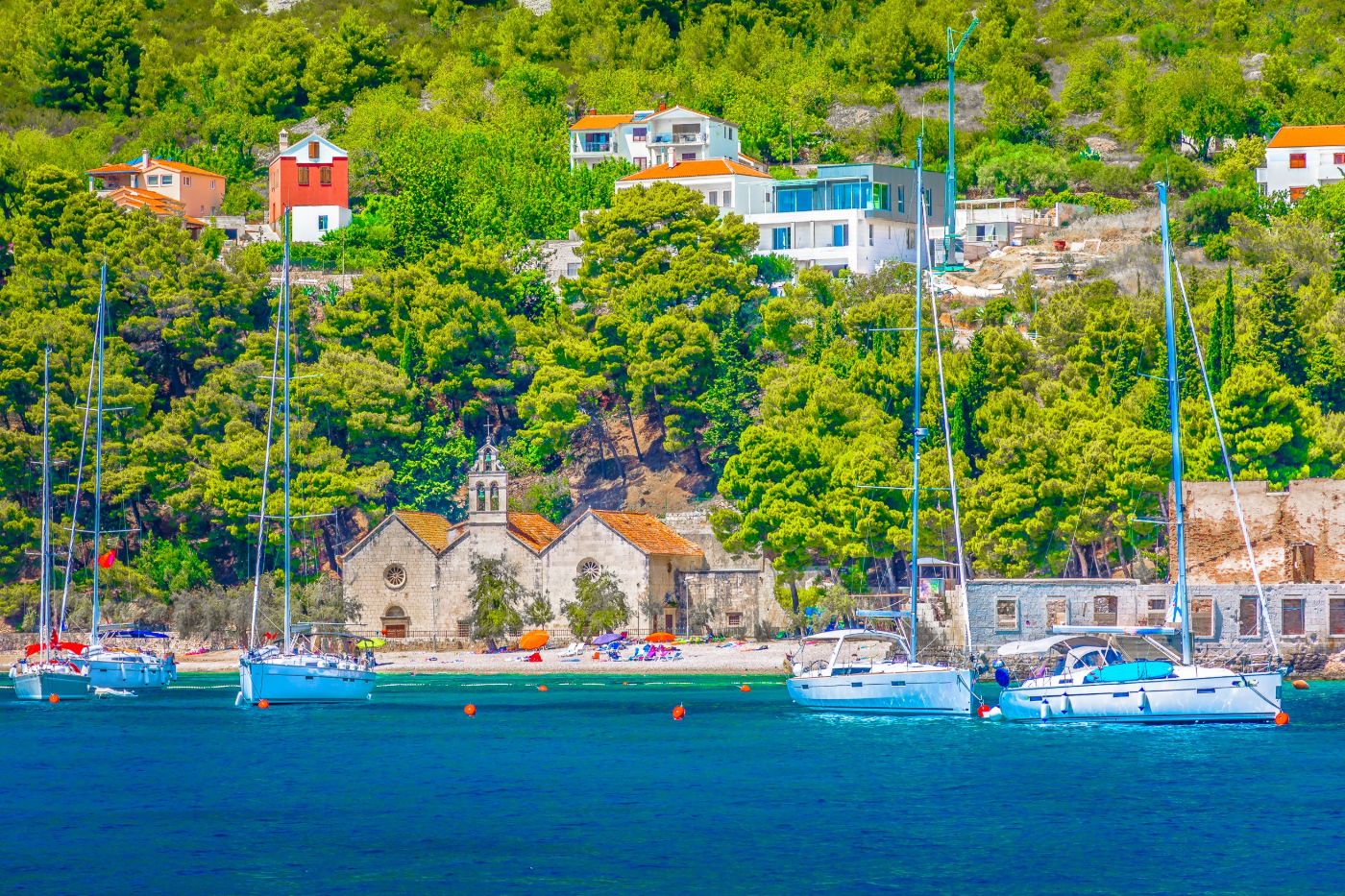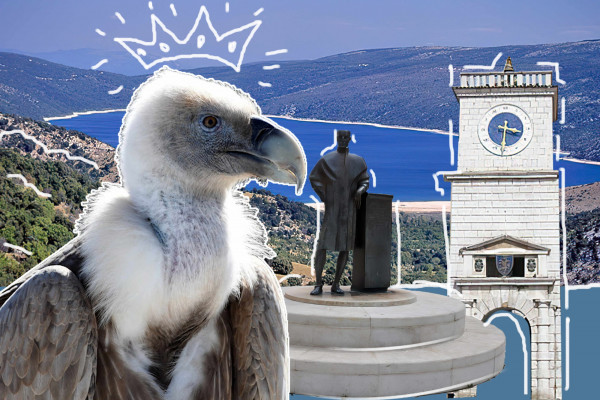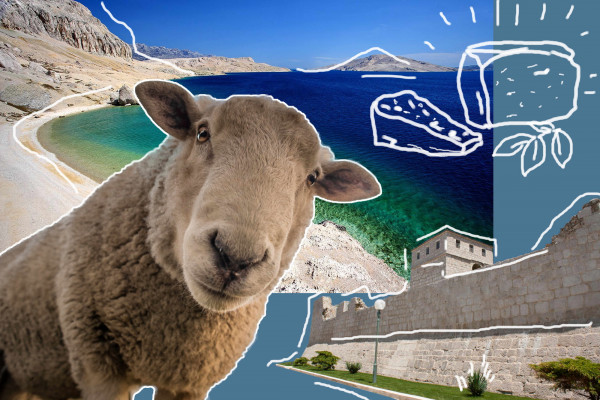Show all photos
(18)
A Guide for a Three Days on the island of Vis
Day one
The town of Vis
Morning
The history of the island of Vis has been in constant motion since the ancient times. Beneath it sleeps the ancient town of Issa, remains of which often converged with the town’s later-date architecture. But the ancient Greeks and Romans were not the only ones to leave their mark on the cityscape of this beautiful town. The British and the Austrians built their forts here, and in most of Vis churches you’ll find a blend of different architectural and artistic styles. We recommend that you start your first day on the island with a good long walk through the town of Vis, and explore all of its nooks and crannies while soaking up the Mediterranean atmosphere of this charming place that has been flourishing for centuries. For that purpose we have selected some of the most interesting places and we hope they will impress you as much as they have impressed us.
1. The Roman baths and the Issa necropolis are located in the northern part of the port of Vis. If you continue to follow the road that leads through the bay, you will reach the small peninsula of Prirovo, the location of the Issa theatre. The Benedictines built their monastery here in the 16th century, so the remains of the theatre are embedded into its walls.
2. The Church of St. Cyprian and Justine was built in 1742 on the site of a former Gothic church. Its mix of the Baroque, late Baroque and Gothic styles gives it a unique interior. The statue of St. Cyprian adorns the facade of the church, and his image, along with that of St. Justine and several other saints, can be seen on the altarpiece as well.
3. The Church of Our Lady of Spilica. During construction, the floor plan of this church was constantly changing as new parts were added to it, so its architecture has the features of three different architectural styles - Gothic, Renaissance and Baroque. Its bell tower is the tallest bell tower in Dalmatia.
4. The Bataria Fort (The Fortress of Our Lady) was built by the Austrians during the 1830s. It is perhaps best known for its role in the Battle of Vis in 1866, when its weapons overpowered the Italian fleet under the command of the French admiral de Saint-Bon.
5. The Archaeological Museum of the town of Vis, located in the Bataria Fort, houses the largest collection of artefacts from the Hellenistic period found in Croatia. The star of its archaeological show, however, is its hydro-archaeological collection. It contains a large number of mint-condition amphorae found in the Vela Svitnja bay. The amphorae are exhibited exactly as they were carried in the lower deck of the ship that transported them. During the summer season, the museum is open until 9 pm so you can visit it in the evening, as well.
6. The Perasti Tower was built by Vicko Perasti in 1617 on his own property. It wasn’t unusual for the people of Vis to built their private forts and towers for the purpose of protecting themselves from enemy attacks. This tower was equipped with small bronze cannons and sentry boxes, one in each corner of the fort.
7. The Church of St. George was built in the 9th century and restored in the 16th and 17th centuries, and thus makes a fine example of blended architecture so often found on Vis. It was dedicated to St. George, the patron saint of the town of Vis, and it might be interesting to note that in the 15th century it was inhabited by hermits.
8. Fortica - Fort King George is probably the most famous fortress in the town of Vis, built by the British Royal Navy. At that time is was well equipped for its military purpose, with warehouses, gunpowder room, soldier and officer barracks, and a rainwater harvesting system. Nowadays it houses an art gallery, a restaurant and a lounge bar. Fortica is an ideal spot for your mid-walk coffee or lunch. During the summer season it is open for concerts and various social events which makes it a great place for evening entertainment.
There’s no need to rush your unique Vis experience. Take a break in one of the many coffee shops and bars hiding in the cobbled streets of Vis and enjoy your break in the easy Dalmatian way. When you get hungry, crown your walk with a lunch in one of the many restaurants.
Whichever you choose, you won't be disappointed - you will find an excellent Mediterranean menu and top service in all of them.
However, we might be able to narrow it down for you by recommending Mvuseum Vis (coffee and cocktails are great here) and Pizzeria Kariola which offers a nice salad menu to go with the pizza of your choosing (be sure to try the famous Komizha savoury pie, the traditional dish of Vis). And if you’re looking for the best view to go with a superb menu, you can find it on the terrace of Fortica.
Afternoon
After a splendid walk and an great lunch, you may find yourself looking to relax and refresh. In this case we suggest you head to one of the beaches of the town of Vis.
1. The town beach Prirovo is located on the northern side of the peninsula of the same name (not far from the Benedictine monastery which was built on the remains of an ancient Roman theatre you may have already visited on your walk). It is shaded by plenty of trees so the afternoon here will be pleasant even during the warm hours. In case you want a drink you’ll find several bars in the vicinity of the beach, along with a volleyball court and a smaller football field.
2. Grandovac beach is located at the eastern entrance to the port of Vis, in a small bay of the same name. The refreshing shade of pine and tamarisk trees makes this beach suitable for an afternoon visit. This spot offers a lovely view of the port of Vis. If you’re looking to get a tan you’ll be able to sunbathe on the fine pebbled terrain of the beach as well as the plateau next to it, built for that very purpose. You can sit for your afternoon coffee or tea in the nearby cafe.
Evening
1. No day in any city is quite complete without experiencing its night life and the same holds true for the town of Vis. We recommend you go back to its streets after sundown and see what they look like dressed in a summer’s evening. We’ll reveal only this: they turn into a cheerful Mediterranean stage for the many events of the Vis cultural summer. Wherever you turn, whichever street you choose to go down you will come across amateur theatre performances, art workshops, music events, recitals and street artists, all blending together to paint this eternal city in an unforgettable summer joy.
2. For your evening meal we recommend you book a table in one of the restaurants on the coastline of the town. If you want to enjoy a fine fish dish head out to the restaurant Villa Kaliopa, located in a Gothic-Renaissance garden full of palm trees (it looks particularly attractive in the evening hours). Restaurant Boccadoro (Hotel San Giorgio) takes pride in its passion for cooking so the menu is exquisite, and you will be dining in a charming intimate atmosphere of a quiet Dalmatian street. In Konoba Lola, located in the very centre of Vis, you will be taking your dinner in a cozy garden full of plants and flowers, against a carefully selected musical backdrop.
3. Being open till 9 pm, a visit to the Archaeological Museum of the town of Vis will start you evening off quite nicely. If you prefer spending your evening in a more intimate atmosphere, we recommend you visit Fort King George (even if you have already been there in the morning). Under the pine trees, with the light of lanterns and candles everywhere around you, you will enjoy a lovely menu - a combination of traditional and modern dishes - and a gorgeous night time view of the sea.
Day 2
The island of Vis is rich in natural beauty, so we suggest that you set aside one day for a tour of its most beautiful and interesting parts.
Many tourist agencies on the island offer a number of excursions and tours around the island of Vis and its archipelago. For all adventurers among you, the travel agency Alternatura offers a wide range of historical, cultural and gastronomic excursions. However, you can explore Vis on your own and in more than one way.
Morning
1. Hiking on the island of Vis
There are about twenty hiking routes and trails on the island, all of which are well marked. The trails start from the town of Vis or Komiža and lead through either of the towns, and then further out, along the coast towards the bays and beaches, or inland, across the fields and meadows, towards Hum. You can find a map of the routes and trails in the tourist boards of the town of Vis and the town of Komiža. Whichever trail you choose, it won't take you more than four hours to complete it, but be sure to bring enough water. We suggest that you choose routes that end on one of the beaches and bays of the island of Vis (Stončica, Ruda, Milna). In this way you will be ending your hike with a swim and a nice lunch in the restaurants located near these beaches.
2.Cycling on the island of Vis
Although Vis has no trails designed for cycling alone, you will be able to take your bike down one of the established bike routes. They will take you over the already mentioned hiking trails, but also macadam roads, field trails and paved roads. If you’re looking to challenge yourself, the cycling enthusiasts of the Arcicija cycling club (in the town of Vis) will help you come up with a personalized route. Depending on where the road takes you, you will be able to stop in one of the villages and hamlets and partake in the local gastronomy.
Afternoon
1. If you want to treat yourself to something nice, we suggest you embark on a wine tour. The island of Vis has been known for its quality wine since the ancient times, especially popular in the Austro-Hungarian era, when it was exported to all corners of the then empire. The Vis tradition of viticulture is many centuries old and vouches for the quality of every bottle of wine made here, the most famous being Vugava and Plavac.
You can book your place on the wine tour in several of the tourist agencies on Vis. We heartily recommend that you spend at least a part of your day visiting the vineyards of the most famous Vis winemakers, tasting their wines and products and having a look around their wine cellars. This way you will enjoy great wine against the backdrop of the wonderful Vis landscape, under the warm Mediterranean sun, over stories and anecdotes about wine, Vis and the good old ancient times.
2. If you would rather continue hiking, we suggest you visit the highest peak of the island of Vis - Hum. Perched at 527 meters above sea level it offers a fantastic view of Kornati Islands, Pelješac Island, the Velebit Mountain, and even the distant islands of Lastovo and Jabuka. Along with the stunning view you’ll find a charming little Church of the Holy Sprit here, as well.
There are two hiking trails that will lead you to Hum: Trail Vis - Bratoslavac - Čajno Polje - Žena Glava - Hum and Trail Vis - Vela Glava - Žena Glava - Hum. Either will take you about three and a half hours to complete (on foot), and both take you past Tito's Cave in case you want to include it in your adventure. When you get hungry, retrace your steps towards the little village of Žena Glava (charming unusual name that translates literally as Woman Head).This place is known for its delicious local gastronomy and will make an excellent place for lunch or an early dinner.
Evening
If, at this point in the day, the roads and trails have not yet taken you to one of the beautiful beaches of Vis (and even if they have), we suggest that you end your day by admiring the sunset on one of them.
1. Srebrna beach (Silver beach) just might be the best place to spend the evening. Its large white pebbles and its turquoise sea work together to create a landscape that’s right out of a dream. In the evenings, the white pebbles sparkle under the light of the moon, turning the beach into a world of sea magic. (https://tourist.hr/place/srebrena-beach)
2. The hiking trail Vis - Kut - Zlo Polje - Stončica will take you directly to Stončica beach, located in the eponymous bay. It is an excellent choice for a late afternoon swim and an early dinner. The restaurant Konoba Stončica is surrounded by a pleasant shade of tamarisk trees, has a really great Mediterranean menu, and offers a beautiful view of the bay to go with your dinner.
Day 3
Komiža
Now that you’ve seen the island’s inland charm, we suggest you have a look at what the west coast of the island looks like. The best way to go about this is to start your day in Komiža. This charming fishing village has a particularly lovely cityscape: stone houses and cottages built wall to wall, huddled together, with the occasional church or a fort towering over them protectively. As you’re strolling down the streets of Komiža you’ll be able to sense how different its soul is from that of the town of Vis: here, the sea, the salt and fishing are woven into the spirit of the place, its coast and all its streets.
Morning
Walking down Komiža’s narrow streets you will again and again come across something that’s escaped your notice before, so your morning walk will make for a nice sightseeing adventure.
1. One of the places you simply have to visit is Kaštel Komuna. This fort was built in 1595 to help defend the town from pirates and Turks. Its construction was partly financed by the fishermen of Komiža. During the first decades of the 19th century it served as barracks for the British troops; by the end of that century the municipality of Komiža bought it for its own use. Today it is the home of the Fishermen's Museum, the best place to find out all you want to know about the history of Komiža.
2. While the eastern part of the island was of great military interest to various foreign armies that have tried to either conquer or defend it, the Komiža coast, undefended and facing the open sea, was very attractive to pirates. They left their mark on the history of Vis, too, and one of the churches in Komiža bears witness to this.
The Church of St. Mary is best known as Our Lady of the Pirates due to an interesting story that is associated with it. In one of the pirate attacks, that occurred sometime around the middle of the 16th century, this church was looted, as was often the case during pirate incursions. One of the things they stole was the painting of the Virgin Mary. The pirates apparently had trouble navigating their way out of the bay and while escaping threw the painting overboard, which floated back to the shore.
The people of Komiža took this to be a blessing and gave the church its new name, still widely used today.
3. Don’t miss to visit the Church of St. Nicholas - from 13th to 15th centuries it was a part of the Benedictine monastery in Komiža. Its original architecture was added to after this period and thus embellished with the stylistic features of the Romanesque and the Baroque periods. A defensive wall with bronze cannons was built next to the church so that it could double as a fort.
4. After your Komiža walk we suggest you take yourself out to sea and visit the little island of Biševo. We have two very good reasons for suggesting this. First is the church of St. Sylvester and the remains of the Benedictine monastery that was built next to it. The second is the Blue Cave, a true pearl of natural beauty and an almost mandatory part of every visit to Vis because of the unique light phenomenon that occurs inside it.
The sunlight enters the cave through the underwater opening and is refracted, thus illuminating the cave and the sea in it with a beautiful, magical blue light.
You can get to Biševo and the Blue Cave by joining an organized trip in one of the Komiža tourist agencies. You can also go sightseeing yourself. When renting a boat (you can do it in one of the taxi boat agencies in the port of Komiža) just remember to say where you’re headed, since only small boats are allowed to enter the cave.
Afternoon
1. By the time you return from Biševo it will probably be lunch time, so we recommend that you try the fish menu in one of Komiža's restaurants. Komiža is the cradle of fishing (in the Adriatic and beyond), and Komiža’s fishermen have spent centuries perfecting the art of fishing and the art of cooking fish. The best fish on the island is right here and, figuratively speaking, it will go straight from the sea and right onto your plate.
2. The afternoon hours are perfect for the exploration of Komiža’s nature. The bay of Komiža is full of beaches, whether public or hidden, and each will win you over with its deep shade of trees, and a calm and clean sea.
We recommend a visit to the beach Gusarica, not far from St. Mary’s Church, the same beach to which the stolen painting of The Virgin Mary returned after being discarded by the pirates.
Lučica beach, another lovely spot to visit, is surrounded by old stone houses and a large breakwater. Swimming here could be pretty interesting: the fresh water coming from the underwater spring is slightly cooler than the sea itself, so if you feel the water temperature suddenly changing you’ll know what’s causing it.
3. If you want to experience a genuine old Dalmatian village head out to Dragodid. It was built by the Suić family at the beginning of the 19th century, in the vicinity of their vineyards. After decades of being completely abandoned the village sprang back to life at the beginning of the 21st century, when the renovation began. Sitting stone-pretty in the lovely Mediterranean landscape this place is ideal for a picnic.
Evening
For your evening entertainment, go back to Komiža because, just like the town of Vis, Komiža has its own cultural summer. Depending on the schedule, there’s something going on every night.
The repertoire usually includes art exhibitions, film screenings, children's theatre plays, stand-up comedy, concerts by traditional Dalmatian a-capella bands (‘klapa’) and acoustic ensembles, dance workshops, lectures, recitals and book readings. The biggest event in Komiža is definitely the Komiža Fishermen's Night, which takes place on the first Saturday in August. On this night, Komiža springs to its full summer life with music and the scents of traditional fish dishes.
Komiža often hosts the Wine Festival, the Tourism Festival and the Short Story Festival, too. With so many options you will definitely find something that suits your tastes.
If you’re looking for somewhere to dance to the beat of the dance-chart hits, Aquarius Disco Club is the place to go to. In any case, we recommend that you spend your last evening on the island of Vis cheerfully, relaxed and in good company, in one of the cafe bars on the shore, with a glass of Vugava or Plavac, and an evening view of the harbour and the sea.
Guide Type
Combined
Itinerary
The town of Vis, place 1
Martvilo Issae Necropolis
The town of Vis, place 1
Martvilo Issae Necropolis
The Roman baths and the Issa necropolis are located in the northern part of the port of Vis. If you continue to follow the road that leads through the bay, you will reach the small peninsula of Prirovo, the location of the Issa theatre.
The town of Vis, place 2
The Church of Saint Cyprian and Justine
The town of Vis, place 2
The Church of Saint Cyprian and Justine
The Church of St. Cyprian and Justine was built in 1742 on the site of a former Gothic church. Its mix of the Baroque, late Baroque and Gothic styles gives it a unique interior. The statue of St. Cyprian adorns the facade of the church, and his image, along with that of St. Justine and several other saints, can be seen on the altarpiece as well.
The town of Vis, place 3
The Church of Our Lady of Spilice
The town of Vis, place 3
The Church of Our Lady of Spilice
During construction, the floor plan of this church was constantly changing as new parts were added to it, so its architecture has the features of three different architectural styles - Gothic, Renaissance and Baroque. Its bell tower is the tallest bell tower in Dalmatia.
The town of Vis, place 4
Bataria Fort
The town of Vis, place 4
Bataria Fort
The Bataria Fort (The Fortress of Our Lady) was built by the Austrians during the 1830s. It is perhaps best known for its role in the Battle of Vis in 1866, when its weapons overpowered the Italian fleet under the command of the French admiral de Saint-Bon.
The town of Vis, place 5
Archaeological museum Vis
The town of Vis, place 5
Archaeological museum Vis
The Archaeological Museum of the town of Vis, located in the Bataria Fort, houses the largest collection of artefacts from the Hellenistic period found in Croatia. The star of its archaeological show, however, is its hydro-archaeological collection. It contains a large number of mint-condition amphorae found in the Vela Svitnja bay. The amphorae are exhibited exactly as they were carried in the lower deck of the ship that transported them.
The town of Vis, place 6
The Persati Fort / The Perasti Tower
The town of Vis, place 6
The Persati Fort / The Perasti Tower
The Perasti Tower was built by Vicko Perasti in 1617 on his own property. It wasn’t unusual for the people of Vis to built their private forts and towers for the purpose of protecting themselves from enemy attacks. This tower was equipped with small bronze cannons and sentry boxes, one in each corner of the fort.
The town of Vis, place 7
The Church of Saint George
The town of Vis, place 7
The Church of Saint George
The Church of St. George was built in the 9th century and restored in the 16th and 17th centuries, and thus makes a fine example of blended architecture so often found on Vis. It was dedicated to St. George, the patron saint of the town of Vis, and it might be interesting to note that in the 15th century it was inhabited by hermits.
The town of Vis, place 8
Fort George
The town of Vis, place 8
Fort George
Fort King George is probably the most famous fortress in the town of Vis, built by the British Royal Navy. At that time is was well equipped for its military purpose, with warehouses, gunpowder room, soldier and officer barracks, and a rainwater harvesting system. Nowadays it houses an art gallery, a restaurant and a lounge bar. Fortica is an ideal spot for your mid-walk coffee or lunch.
The town of Vis, special place
Mvuevm Vis coffee and wine bar
The town of Vis, special place
Mvuevm Vis coffee and wine bar
Located in the heart of the town of Vis, this coffee shop and wine bar offers a great wine list with a large selection of sparkling wines, champagnes and prosecco. Their specialty coffee is fantastic, made from a mildly roasted, 100% Arabica sort.
The town of Vis, special place
Pizzeria Kariola
The town of Vis, special place
Pizzeria Kariola
Pizzeria Kariola offers a great pizza menu, which comes as no surprise since it is one of the best pizza places in Croatia. Aside from the usual ingredients their pizzas are enriched with olive oil, various types of cheese, shiitake mushrooms and smoked beef. In case you’d like a salad to go with it, you’ll be able to find plenty of those on the menu, too. Be sure to try the Komizha bread, the traditional savoury pie of the island of Vis.
The town of Vis, beach 1
Prirovo beach
The town of Vis, beach 1
Prirovo beach
The town beach Prirovo is located on the northern side of the peninsula of the same name (not far from the Benedictine monastery which was built on the remains of an ancient Roman theatre you may have already visited on your walk). It is shaded by plenty of trees so the afternoon here will be pleasant even during the warm hours. In case you want a drink you’ll find several bars in the vicinity of the beach, along with a volleyball court and a smaller football field.
he town of Vis, beach 2
Grandovac beach
he town of Vis, beach 2
Grandovac beach
Grandovac beach is located at the eastern entrance to the port of Vis, in a small bay of the same name. The refreshing shade of pine and tamarisk trees makes this beach suitable for an afternoon visit. This spot offers a lovely view of the port of Vis. If you’re looking to get a tan you’ll be able to sunbathe on the fine pebbled terrain of the beach as well as the plateau next to it, built for that very purpose. You can sit for your afternoon coffee or tea in the nearby cafe.
The town of Vis, evening 1, place 1
Vis
The town of Vis, evening 1, place 1
Vis
No day in any city is quite complete without experiencing its night life and the same holds true for the town of Vis. We recommend you go back to its streets after sundown and see what they look like dressed in a summer’s evening. We’ll reveal only this: they turn into a cheerful Mediterranean stage for the many events of the Vis cultural summer.
The town of Vis, evening 1, place 2
Restaurant Villa Kaliopa
The town of Vis, evening 1, place 2
Restaurant Villa Kaliopa
Located in a gothic-renaissance yard built in the 16th century and surrounded by palm trees, this gorgeous restaurant will make a great location for your evening meal. They have a great fish menu along with the traditional Dalmatian cuisine. Eating here will be a well rounded experience, but make sure to book a table beforehand because hardly anyone can resist fine dining in a beautiful Mediterranean setting.
The town of Vis, evening 1, special place
Restaurant Boccadoro
The town of Vis, evening 1, special place
Restaurant Boccadoro
A number of ingredients the chefs of Boccadoro use in their cooking come straight from their own organic garden. Not surprising, since this restaurant is dedicated to the process of food preparation and creates little culinary masterpieces on a daily basis. You’ll be dining in the intimate atmosphere of a stone courtyard decorated with flowers and you will be pampered all the way through.
The town of Vis, evening 1, special place
Restaurant Lola
The town of Vis, evening 1, special place
Restaurant Lola
The space of this restaurant is so beautiful that it is often rented out for various kinds of events. Dining here you will be sitting in a charming flower garden, against the backdrop of lovely music, in an intimate atmosphere. The menu will delight you as well: it is a combination of Mediterranean dishes with a touch of the Spanish cuisine. The beverage offer includes the best Vis wine and cocktails and you can relax over any of those in the venue’s lounge bar, as well.
The town of Vis, evening 1, place 3
Archaeological museum Vis
The town of Vis, evening 1, place 3
Archaeological museum Vis
This museum is a must-see, even for those who are not necessarily interested in archaeology or history. Located on the coast of the town of Vis, in the Batarija Fort, it is a home to numerous artefacts from the Hellenistic period (the largest Hellenistic collection in Croatia) as well as local pottery and various costumes and tools used in fishing by the people of Vis throughout history.
The town of Vis, evening 1, special place
Fort George
The town of Vis, evening 1, special place
Fort George
Fort George, named after the British King George III. Is one of the fortifications built by the British Royal Navy after their 1811 victory in the Battle of Vis. It served as a sort of an international garrison for various armies, including the Italians, the Suiss Guard and the Corsicans. It was in use for two hundred years before it was abandoned.
The island of Vis
Wine tour
The island of Vis
Wine tour
You can book your place on the wine tour in several of the tourist agencies on Vis. We heartily recommend that you spend at least a part of your day visiting the vineyards of the most famous Vis winemakers, tasting their wines and products and having a look around their wine cellars. This way you will enjoy great wine against the backdrop of the wonderful Vis landscape, under the warm Mediterranean sun, over stories and anecdotes about wine, Vis and the good old ancient times.
The island of Vis
The Church of the Holy Spirit
The island of Vis
The Church of the Holy Spirit
You will find this old church on the highest peak of the island of Vis - 560 meters above sea level, rising above Hum. Judging by its appearance alone you might mistake it for a stone cottage, the cross perched on top of will might be the only thing to tell you otherwise.This adorable little church standing in the wilderness of Vis seems to have been built in the 15th century, a conclusion drawn from the Gothic style of its vault.
The island of Vis
Tito's Cave
The island of Vis
Tito's Cave
Tito's Cave is located below Hum, the highest peak of Vis, formerly known as Ghost's Cave, after former Yugoslav President Tito was there, while the cave served as the seat of the partisan army. Tito sought refuge after Nazi troops tried to kill him in Drvar, and in 1944 he spent time in a cave (equipped and remodeled to provide a safe and comfortable stay for one of the most powerful people in the world at the time).
The island of Vis
Srebrena beach
The island of Vis
Srebrena beach
Srebrna beach (Silver beach) just might be the best place to spend the evening. Its large white pebbles and its turquoise sea work together to create a landscape that’s right out of a dream. In the evenings, the white pebbles sparkle under the light of the moon, turning the beach into a world of sea magic.
The island of Biševo
The Blue Cave
The island of Biševo
The Blue Cave
The Blue Cave, located on the small island of Bishevo, is not your garden variety kind of a cave. Here, the sunlight and the sea interact together in a dance to create the amazing silver and blue illuminations this cave gets its name from. The sunlight actually comes in through the underwater entrance to the cave and hits the water, creating the blue. Depending on the refraction angle, the light sometimes illuminates the cave with a silver glow, as well, a result of all the colours mixing together into one.
The island of Vis
Beach Gusarica
The island of Vis
Beach Gusarica
Small, soft pebbles and a shallow entrance to the clear sea make it an ideal beach for family vacations, children and the elderly. It is easily accessible, accessible by car, scooter, bicycle or on foot. The beach is located near the beautiful church of St. Mary, known as Our Lady of Pirates built in the 16th century, after which the beach got its name - Gusarica (Pirate).
The island of Vis
Dragodid
The island of Vis
Dragodid
If you want to experience a genuine old Dalmatian village head out to Dragodid. It was built by the Suić family at the beginning of the 19th century, in the vicinity of their vineyards. After decades of being completely abandoned the village sprang back to life at the beginning of the 21st century, when the renovation began.
Guide Location
Traveler type
All types of travelers

